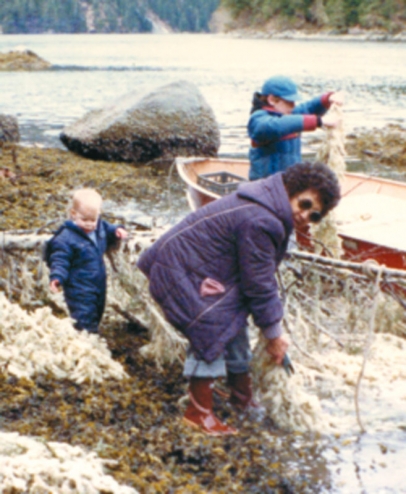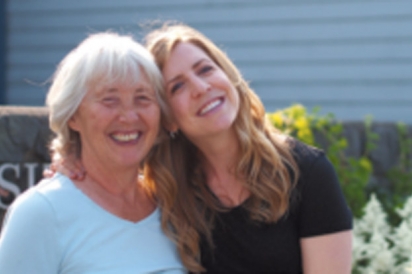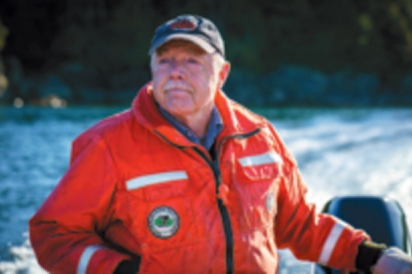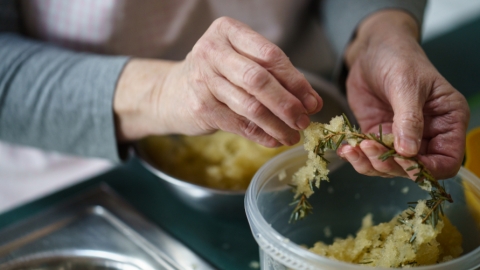Spring Staple | Herring Roe
I grew up in Pelican and Sitka in Southeast Alaska, where the annual arrival of herring is a staple of spring. As a child it was especially exciting. Boats came from around the region for the commercial herring sac roe (roe in their egg cases) fishery near Sitka, sometimes jockeying for multi-million dollar hauls within sight of town while small planes buzzed overhead, spotting herring shoals for boat captains below. Warmer, sunnier weather arrives with the fish, and the ocean turns a light turquoise as it fills with herring spawn. It is the closest Sitka comes to feeling like it’s on a tropical island.
In 2018, the harvest level for the fishery was 11,000 tons of sac roe, most of which was harvested by commercial operations that sell to Asian markets. The value of the 2017 harvest was $4.3 million. But then there are small operations like my family’s, a subsistence ritual we undertake each year when we “set” hemlock branches to collect the herring’s precious eggs.
Although I now live in Anchorage, I have fond memories from my childhood as year after year we would participate in this ritual. In late March or early April as the herring started to arrive in massive, balling clumps to spawn, my parents would bundle us up for skiff rides out to little coves and inlets beyond town. Usually my grandparents, Amelia and Saburo (Sam) Kito, would join us. They were of Tlingit and Japanese heritage — two cultures that prize herring, both for its value as food and its cultural significance. Grandpa Kito passed away in 1990 when I was four years old, so I don’t have memories of him on these trips. But my parents tell me he loved this annual spring “egg hunt.” He and Grandma Kito would come over from their home in Fairbanks to meet us in Pelican and work as a team to harvest the eggs, hauling up heavy, wet branches laden with the gauzy, clustered roe.
In my head is the vivid memory of Grandma Kito sitting in the skiff, dressed in several layers (usually purple), eager with anticipation as we checked sets of hemlock branches for that season’s treasure. Though we also ate the actual fish, the herring eggs were the real prize.
The process of setting and collecting branches was always a gamble. My father would guide the skiff to a calm cove, a place we chose based on our best guess from past years, where the herring might decide to rest as they lay their eggs. Then we would tie a cut hemlock branch to a buoy, usually an empty milk jug marked with our initials, and set the rig in a moderately shallow spot. A few days later we’d return and pull it up. If we had guessed correctly, the branches would be covered in millions of translucent-white eggs, almost obscuring the green hemlock needles. And not just on the branch; when herring spawn on a massive scale, the huge amount of roe produced clings to rocks, kelp, boats — anything even remotely sedentary in the surrounding water.
After dragging our bounty into the boat we would peel the eggs right off the branch for a sample. The crisp taste of hemlock mingles with sea salt in a distinctive crunch, lacking the fishy tinge of most caviar. Instead, it feels like taking a bite right out of Southeast Alaska. To taste fresh herring eggs out of the water is to taste spring in the shores and shoals of the Alexander Archipelago.
In spring 2018, the Sitka sac roe herring fishery shut down early, falling 8,330 tons short of the guideline harvest level. This was the fourth time in the past six years the herring fishery has shut down before meeting the quota. Due to this downturn in supply and harvest, the fishery has been increasingly controversial in recent years. The Sitka Tribe of Alaska, in the interest of continued subsistence harvesting, requested conservation measures at the 2018 Board of Fish meeting, but no changes were made to the formula that determines the quota.
My family would box up and mail bags of eggs right on the branch to family members out of state or in Anchorage who couldn’t get out on the water themselves. When I moved away from Alaska to Washington, DC, my mother started to send me this annual care package — our version of Easter eggs. I would always share some with officemates and fellow graduate school students. After feeding them to Brits, Spaniards, Israelis, Australians, Norwegians, and even some skeptical New Yorkers, I have yet to encounter a person who doesn’t like herring eggs fresh from the branch, dipped in a mixture of melted butter and soy sauce.
After the eggs were harvested, we engaged in family rituals where they were a fixture. Throughout the year we would gather for what my mother’s family affectionately termed “Indian chow,” eating seaweed, fish egg soup, smoked salmon, baked salmon, rice (always lots of white rice), pilot bread with margarine, and in the spring, a variety of herring egg dishes, including raw on the branch, herring egg salad, and pickled herring eggs. There is perhaps no other taste that reminds me as much of my family, my corner of Alaska, my heritage, my Grandpa and Grandma Kito, and my mother than these precious eggs plucked from the sea.











